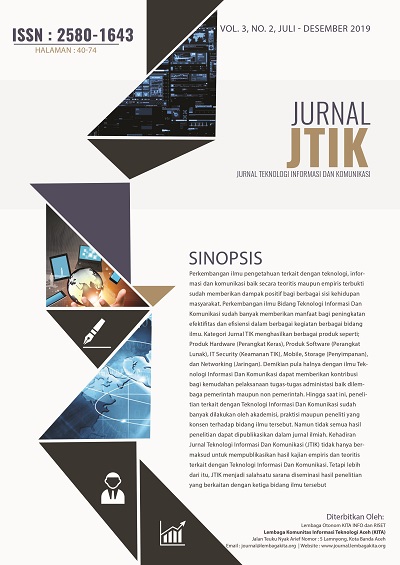Evaluasi e-Tracer Study menggunakan HOT (Human-Organization-Technology) Fit Model
Main Article Content
Abstract
Tracer Study is one of the methods used by several universities, especially in Indonesia to get feedback from alumni. Along with the development of AMIK Indonesia's e-Tracer Study, it needs to be evaluated for use by students and alumni. Evaluation of Tracer Study from the usability aspect can be done to find out a system that can be used by users in the effectiveness, efficiency, and satisfaction. One method that can be used to conduct observation and evaluation is the HOT (Human-Organization-Technology) Fit Model. The method in this study consisted of three stages namely; 1) literature review, 2) discuss theories about information system evaluation models and fit, and 3) analysis and identification of models, and data analysis tools used are SPSS and SmartPLS. From the results of the current research achievements, it can be concluded that in theory, this study has added a reference to the use of the HOT-FIT model for subsequent researchers or other parties in understanding the measurement of the successful implementation of the system, it can be used as a material consideration for the student sector as the manager of the e-system -Tracer Study. There is a deletion of 1 deleted indicator, the LO3 indicator. From 12 hypotheses there are 3 rejected hypotheses, namely IQ → STR, IQ → SU, and LO → NB. the relationship between variables IQ → STR, IQ → SU, and LO → NB did not have a significant effect, based on data analyzed from 124 respondents, 79% stated they use of e-Tracer Study felt very good, 11% felt quite good, and 10% feeling unwell.
Downloads
Article Details

This work is licensed under a Creative Commons Attribution-NonCommercial 4.0 International License.
The Authors submitting a manuscript do so on the understanding that if accepted for publication, copyright of the article shall be assigned to JTIK journal and Research Division, KITA Institute as the publisher of the journal. Copyright encompasses rights to reproduce and deliver the article in all form and media, including reprints, photographs, microfilms, and any other similar reproductions, as well as translations.
JTIK journal and Research Division, KITA Institute and the Editors make every effort to ensure that no wrong or misleading data, opinions or statements be published in the journal. In any way, the contents of the articles and advertisements published in JTIK journal are the sole and exclusive responsibility of their respective authors and advertisers.
The Copyright Transfer Form can be downloaded here: [Copyright Transfer Form JTIK]. The copyright form should be signed originally and send to the Editorial Office in the form of original mail, scanned document or fax :
Muhammad Wali (Editor-in-Chief)
Editorial Office of Jurnal JTIK (Jurnal Teknologi Informasi dan Komunikasi)
Research Division, KITA Institute
Teuku Nyak Arief Street Nomor : 7b, Lamnyong, Lamgugop, Kota Banda Aceh
Telp./Fax: 0651-8070141
Email: jtik@lembagakita.org - journal@lembagakita.org
References
Akbar, R. and Mukhtar, M., 2019. E-Tracer Study Based on Expert Systems (A Case Study at AMIK Indonesia). EPH - International Journal of Science And Engineering. 5(5), pp.12-17.
Dotong, C.I., Chavez, N.H., Camello, N.C., De Castro, E.L., Prenda, M.T.B. and Laguador, J.M., 2016. Tracer Study of Engineering Graduates of One Higher Education Institution In The Philippines For Academic Year 2009-2012. European Journal of Engineering and Technology Vol, 4(4).
Hakim, L., 2017. Perancangan Sistem Tracer Alumni Pada STMIK Musi Rawas Berbasis Web Mobile. JUSIM (Jurnal Sistem Informasi Musirawas), 2(2), pp.108-116.
Hazaymeh, E.N. and Dela Peña, M.K., 2017. A Tracer Study of La Salle University College of Engineering Graduates. Retrieved August.
Lestari, A.D., 2017. Menentukan Skala Prioritas Sistem Informasi Layanan Opac Studi Kasus Di Badan Perpustakaan Umum Dan Arsip Daerah Kabupaten Tulungagung. BIBLIOTIKA: Jurnal Kajian Perpustakaan dan Informasi, 1(1), pp.81-90.
Marisa, F. and Mumpuni, I.D., 2018. Portal Tracer Study Berbasis Social Network Dalam Mendukung Penggalian Data Alumni Dengan Clustering Algorithm. Dinamika DOTCOM, 9(1).
Puspitasari, T.D. and Etikasari, B., 2019. Metode Online Analytical Processing untuk Sistem Informasi Tracer Study. Prosiding SENIATI, 5(2), pp.24-28.
Ramadhani, H. and Monalisa, S., 2017. Analisis Penerapan Sistem Informasi Pengelolaan Nilai Raport Menggunakan Metode Tam. Jurnal Ilmiah Rekayasa dan Manajemen Sistem Informasi, 3(2), pp.65-69.
Rogan, M. and Reynolds, J., 2016. Schooling inequality, higher education and the labour market: Evidence from a graduate tracer study in the Eastern Cape, South Africa. Development Southern Africa, 33(3), pp.343-360.
Rozanda, N. and Masriana, A., 2017, May. Perbandingan Metode Hot Fit dan Tam dalam Mengevaluasi Penerapan Sistem Informasi Manajemen Kepegawaian (SIMPEG). In Seminar Nasional Teknologi Informasi Komunikasi dan Industri (pp. 327-336).
Saputra, I.M.A.D., Pradnyana, I.M.A. and Sugihartini, N., 2019. Usability Testing Pada Sistem Tracer Study Undiksha Menggunakan Metode Heuristic Evaluation. Jurnal Pendidikan Teknologi dan Kejuruan, 16(1), pp.98-108.
Sasongko, D. and Hartanto, R., 2015. Evaluasi perpustakaan digital perguruan tinggi berdasarkan karakteristik perpustakaan digital. Prosiding SNST Fakultas Teknik, 1(1).
Silaen, A.L., Purwanggono, B. and Budiawan, W., 2015. Perancangan Sistem Informasi Tracer Study Dengan Menggunakan Fast (Framework for Application System Technologies). Industrial Engineering Online Journal, 4(3).
Sintiani, I., Fitriani, L. and Kurniawati, R., 2017. Pengembangan Aplikasi Tracer Study STT-Garut. Jurnal Algoritma, 14(1), pp.118-124.
Sri Kamala, N., Haryanti, N., & Suhartika, I. (2018). Efektivitas Online Public Access Catalog (OPAC) sebagai Sarana Penelusuran Sistem Temu Kembali Informasi di Perpustakaan Terpadu Politeknik Kesehatan Denpasar. Jurnal Ilmiah D3 Perpustakaan, 1(1).
Tatipatta, R.V.F., 2019. Penerimaan Teknologi Informasi Employee System Dengan Menggunakan Technology Acceptance Model. Jurnal Perilaku dan Strategi Bisnis, 7(1), pp.41-50.

